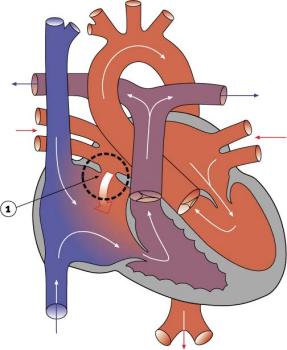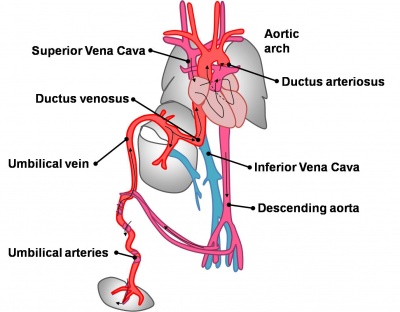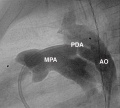Cardiovascular System - Fetal Shunts
Introduction
Fetal circulation differs from the adult predominantly due to the presence of 3 vascular shunts located within the heart and in the vasculature.
- Foramen ovale - in the heart, between the right and left atrium.
- Ductus arteriosus - in the outflow tract, between the pulmonary artery and descending aorta.
- Ductus venosus - in the liver circulation, between the umbilical vein and IVC.
Some Recent Findings
Foramen Ovale
Ductus Arteriosus
Ductus Venosus
Abnormalities
Atrial Septal Defects

|
Atrial Septal Defects (ASD) are a group of common (1% of cardiac) congenital anomolies defects occuring in a number of different forms and more often in females.
ICD-10 Q21.1 Atrial septal defect Coronary sinus defect Patent or persistent: foramen ovale ostium secundum defect (type II) Sinus venosus defect Treatment: The surgical repair requires a cardiopulmonary bypass and is recommended in most cases of ostium secundum ASD, even though there is a significant risk involved. Ostium primum defects tend to present earlier and are often associated with endocardial cushion defects and defective mitral or tricuspid valves. In such cases, valve replacement may be necessary and the extended operation has a considerable chance of mortality.
|
Patent Ductus Arteriosus

|
Patent ductus arteriosus (PDA), or Patent arterial duct (PAD), occurs commonly in preterm infants, and at approximately 1 in 2000 full term infants and more common in females (to male ratio is 2:1). Can also be associated with specific genetic defects, trisomy 21 and trisomy 18, and the Rubinstein-Taybi and CHARGE syndromes. The opening is asymptomatic when the duct is small and can close spontaneously (by day three in 60% of normal term neonates), the remainder are ligated simply and with little risk, with transcatheter closure of the duct generally indicated in older children. The operation is always recommended even in the absence of cardiac failure and can often be deferred until early childhood.
ICD-10 Q25.0 Patent ductus arteriosus Patent ductus Botallo Persistent ductus arteriosus
|
References
Reviews
<pubmed></pubmed> <pubmed></pubmed> <pubmed></pubmed> <pubmed>22117910</pubmed> <pubmed>21513818</pubmed>
Articles
<pubmed></pubmed> <pubmed></pubmed> <pubmed></pubmed> <pubmed></pubmed> <pubmed></pubmed>
Search Pubmed
Search Pubmed: Cardiovascular Fetal Shunt



